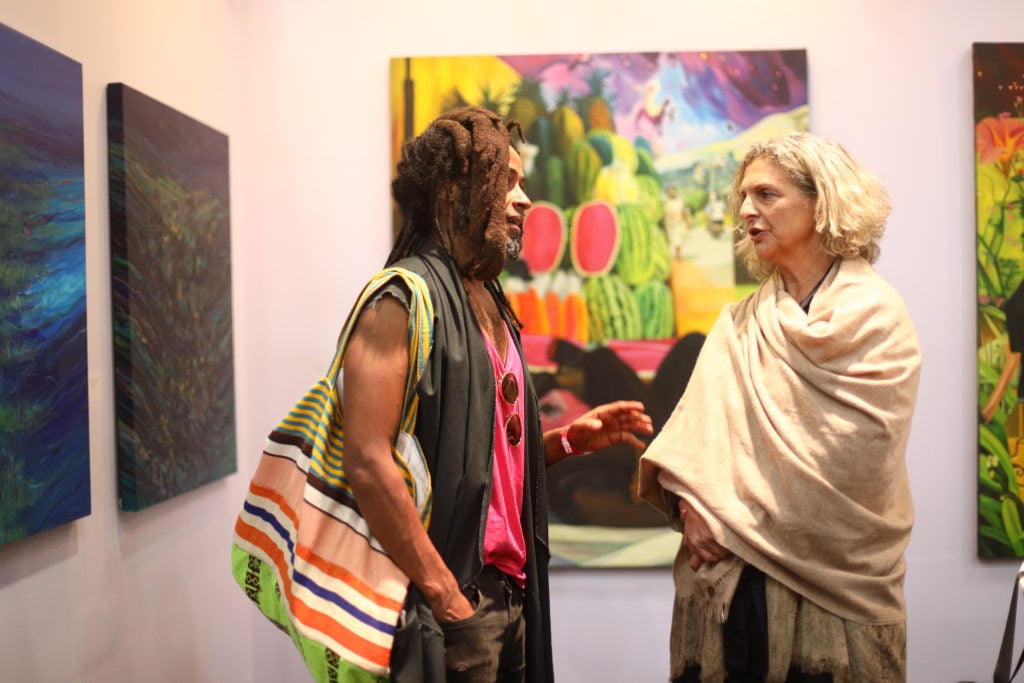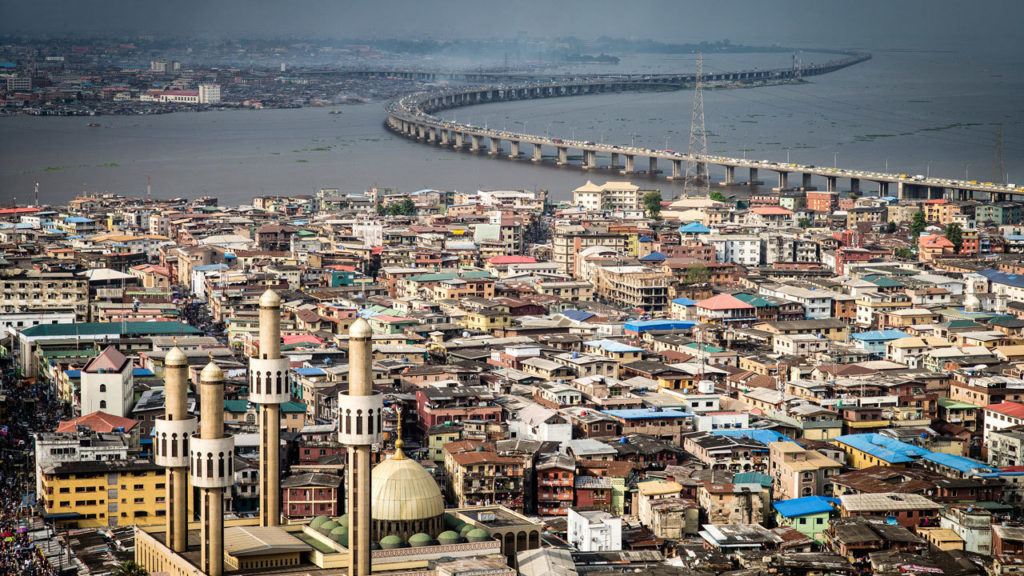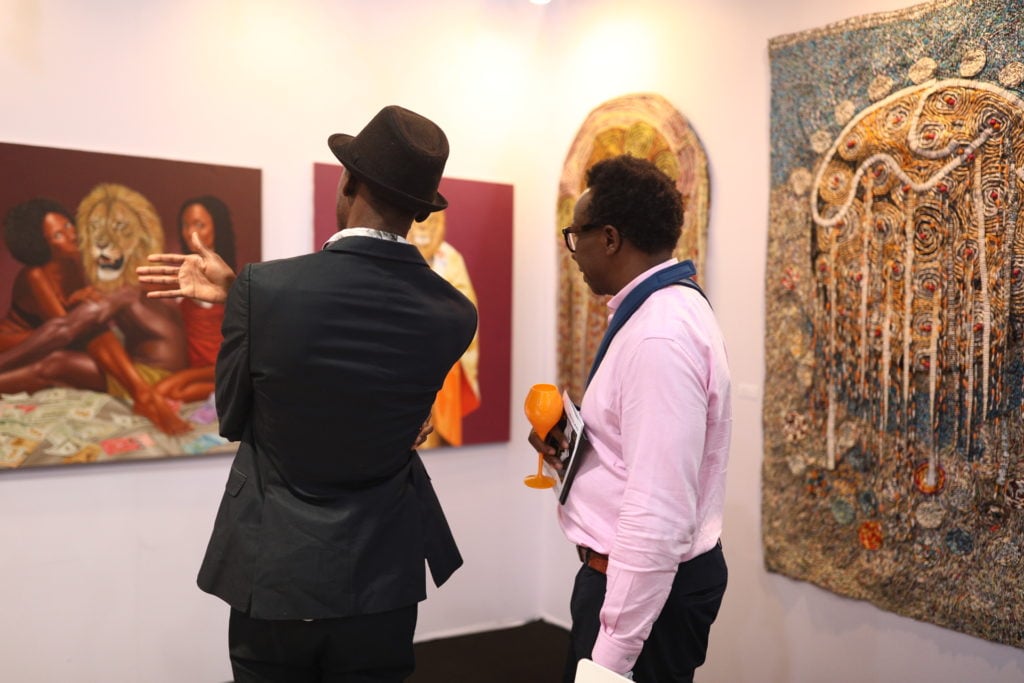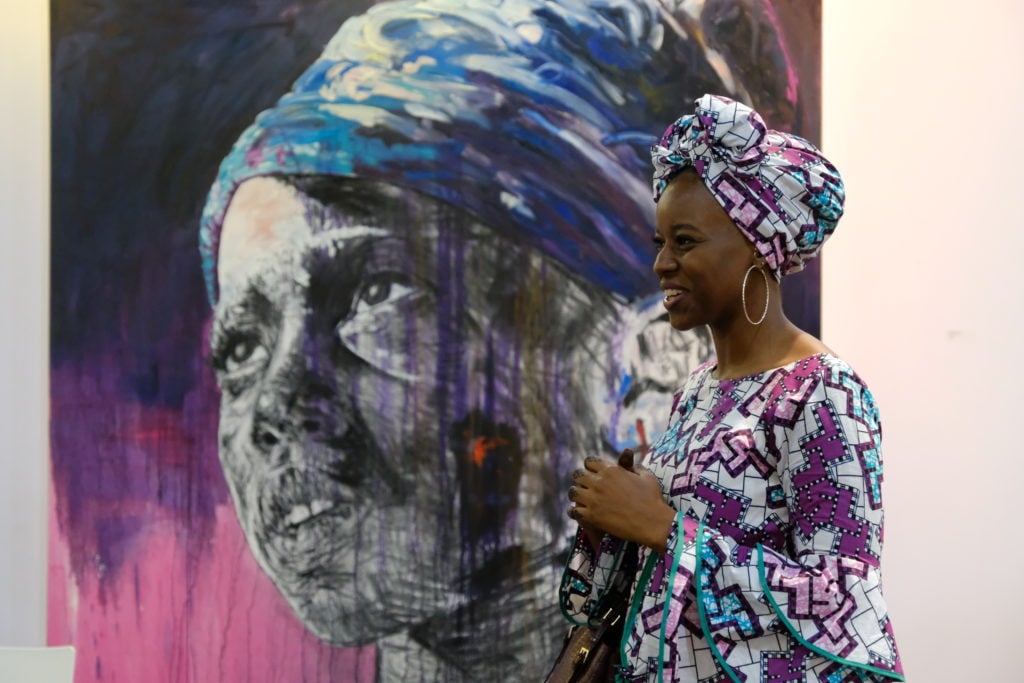From a purely statistical standpoint, Lagos seems like a perfect destination for an art fair. It is the largest city in Nigeria, a country that is home to more black billionaires than any other. It also has one of the largest populations of young people in the world. But it has unique challenges, too: electricity turns on and off without warning, an indication of Nigeria’s energy supply crisis, and its economy has struggled against the backdrop of new measures intended to limit the amount of cash circulating to encourage electronic transactions.
Against this backdrop—and a vibrant street scene of music, dance, and continuous hospitality—Art X Lagos opened its fourth edition in a bid to make its name as Africa’s leading art fair. The event, which ran from November 1 to 3, hosted 22 galleries from across the continent and Europe, up from 18 last year.
“I wanted a bigger space because thousands of people have been coming to Art X Lagos over the last few years,” said the fair’s founder and director Tokini Peterside. “This is a part of the world where it is very difficult to do an art fair and because it doesn’t get done, thousands of people miss out on experiences to do with culture and uplift. This is not just a fair.”

Founder of Nairobi’s Circle Art Gallery Danda Jaroljmek in conversation with a collector. Courtesy of ART X Lagos.
Located this year in Federal Palace on Victoria Island under white-tipped tents that have earned the event the nickname “the Frieze of West Africa,” this year’s Art X Lagos marked a break from its previous location in the Civic Centre. It also boasted a new section dedicated to modern art, where Accra’s Gallery 1957 made early sales of the work of Ghanaian artist Ablade Glover. His abstract paintings—which had not been shown in the country for 15 years—were priced between $10,000 and $15,000 and sold to both Nigerian and international collectors.
“It was important to have a modern section to reinforce to our audience that today’s contemporary artists stem from respected artists and art movements of the past—and to link the contemporary moment to our heritage,” Peterside said.
Prominence of Painting
In a sign of local appetites, one of the most expensive works at the fair—Purple Prose (2018), a large, expressionist portrait of a young girl wearing a cloth around her head by South African artist Nelson Makamo—sold at the stand of first-time participant South African gallery Everard Read for $38,000. “We want to support what is happening here,” said the gallery’s Grace O’Malley. “People here want good work.”
(Everard Read was one of a handful of South African galleries in attendance, an increase from last year. The rise is surprising, given the recent xenophobic attacks of Nigerians in South Africa. At the recent Art Joburg fair in September, three Nigerian galleries were invited to participate but only one managed to get a visa in time due to the closure of the South African embassy in Nigeria amid violent protests in retaliation.)
Makamo’s top-priced painting was indicative of the demand—as true in Nigeria as in most other art markets around the world—for bold, colorful abstract and figurative works on canvas. Particularly in vogue here were works incorporating abstract figures that reference those in traditional Yoruba objects. At first-time participant Dakar-based Galerie Cécile Fakhoury, a large abstract figurative work by Brooklyn-based artist Abdoulaye Diarrassouba, also known as Aboudia, sold for $28,000 to a Nigerian collector.

An aerial view of Lagos, Nigeria. Photo: Michael Kraus/Getty Images.
Hardly any conceptual or minimalist works could be found except for rising star Emeka Ogboh’s two-channel video Ala (2014), which pairs detailed images of Lagos with sound.
“The idea here is to go big,” Kimberley Cunningham of Goodman Gallery said. “Nigerian art collectors generally have very big homes with lots of wall space. In Nigeria, through its fashion and art more is more—it’s always been that way.”
Dealers were divided, however, over whether the buying power was coming primarily from Nigeria or internationally. Goodman, which was returning to the fair after a three-year hiatus with a solo presentation of mixed-media works by Sam Nhlengethwa priced at $10,000 each, sold more than half of its stand—but all to international collectors, not to Nigerians.
At Abuja-based Retro Gallery, on the other hand, works by Nigerian pop artist Williams Chechet all sold to Nigerian collectors for $4,000 each. Meanwhile, Addis Ababa-based Addis Fine Art sold all eight works on canvas by 28-year-old Ethiopian painter Tizita Berhanu priced between $4,500 and $5,500 to mostly local collectors.
Nigerian Buying Power?
The mixed reviews of Nigerian buying power are particularly significant considering that Africa’s largest economy is experiencing a period of slow economic growth. Following new guidelines for a cashless policy in the country released in September by the Central Bank of Nigeria, it continues to be difficult to know just how much the currency, called the Naira, is worth.
The policy, which dates back to 2012, stipulates a cash handling charge on daily withdrawals that exceed N500,000 ($1,381) for individuals and N3,000,000 ($8,287) for corporations in an effort to reduce the amount of physical cash circulating in the economy and encourage more electronic-based transactions.
Danda Jarolimek, director of Circle Art Gallery in Nairobi, says the guidelines may have affected sales at the fair. “This year we only sold to foreigners either living in Nigeria or who had come especially to visit the fair so they all paid in foreign currency,” she said.

Director of Kampala-based Afriart Gallery Daudi Karungi with a collector at his booth. Courtesy of ART X Lagos.
But Kavita Chellaram, owner of Arthouse – The Space, said that despite the cash crunch, “this was the best year we’ve had,” having exhibited at the fair since its inception. Sales included an oil painting by Peju Alatise for $15,000, a screen print by Diana Ejaita for $850, and works by Ngozi Schommers in the range of $5,000 to $10,000.
Nigeria is often touted for its many collectors, but thanks to multiple simultaneous art events in the city, including the Lagos Biennial and Lagos Photo Festival, this year marked the largest number of international institutions in attendance at the fair, including representatives from the Tate, the Smithsonian, the Centre Pompidou, and Zeitz MOCAA.
“I hope fairs like this will help us drop the term ‘African’ in front of ‘artist,’” said Lee Burgers of the Cape Town-based gallery SMAC. “Why can’t we just talk about artists from Africa? Why do we still need to call it an ‘African art fair?’ I feel fairs like this are leading us to a place where we can finally stand on our own two feet and say, ‘This is contemporary art and these are contemporary artists.’”










